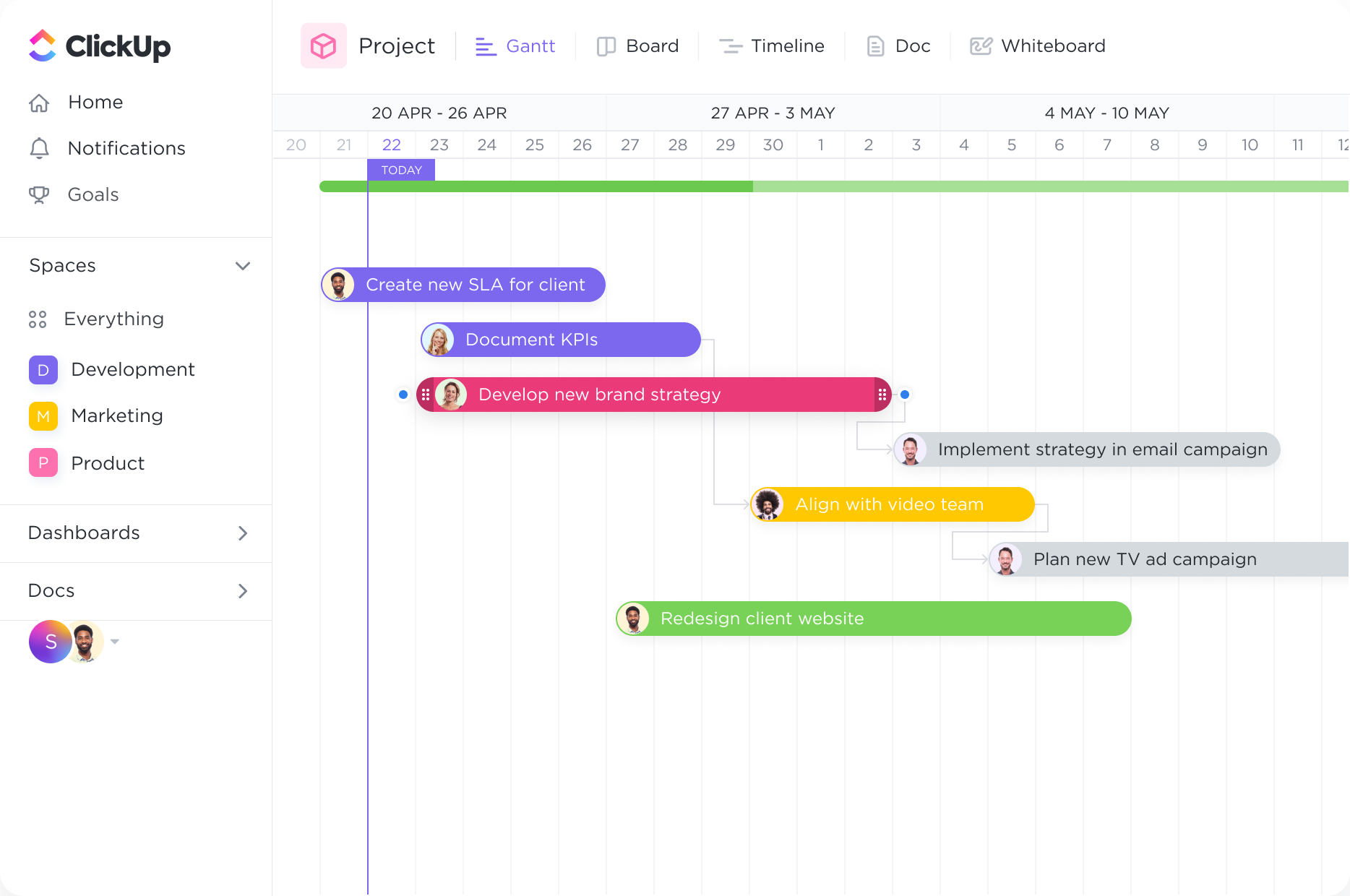Visualize
Organize and set priorities.
Organize how you see your tasks with quick sorting. Create cascading views with a single click to easily see what important tasks are coming next.
Gantt Charts
Create seamless Gantt Charts specifically designed for cinematographers with ClickUp. Streamline your film production process, easily manage tasks, and stay on top of deadlines with our intuitive software. Plan your shoots, allocate resources, and collaborate efficiently all in one place. Take control of your film projects and bring your vision to life with ClickUp's powerful Gantt Chart software.
Free forever. No credit card.

Visualize
Organize how you see your tasks with quick sorting. Create cascading views with a single click to easily see what important tasks are coming next.
Tracking
Intelligent dependency-path tracking shows you where potential bottlenecks might exist to prevent inefficiencies.
Gantt charts are invaluable tools for cinematographers in planning and scheduling film productions. With a Gantt chart, cinematographers can outline the various stages of production, including pre-production, principal photography, and post-production. This visual representation allows them to set realistic timelines, allocate resources, and manage deadlines effectively. By breaking down the project into manageable tasks and milestones, cinematographers can ensure a smooth and efficient workflow throughout the entire film production process.
Film production often involves collaboration among a diverse team of professionals, including directors, producers, editors, and actors. Gantt charts provide a centralized platform for assigning tasks and responsibilities to team members, ensuring clear communication and coordination. Cinematographers can allocate specific shots, scenes, or sequences to camera operators, lighting technicians, and other crew members, streamlining the workflow and promoting efficient collaboration.
Cinematographers rely on a wide range of equipment and resources, such as cameras, lenses, lighting equipment, and props, to bring their creative vision to life. Gantt charts help cinematographers manage and optimize the use of these resources throughout the production process. By scheduling equipment rentals, tracking availability, and avoiding conflicts in usage, cinematographers can ensure that the necessary equipment is readily available when needed, minimizing downtime and maximizing productivity.
Film productions often operate under strict deadlines and require adherence to various milestones, such as script completion, location scouting, and finalizing the shooting schedule. Gantt charts enable cinematographers to incorporate these milestones and deadlines into their project plan. By visually representing these key dates, cinematographers can monitor progress, identify potential bottlenecks, and make informed decisions to keep the production on track. This ensures that the project stays within budget and is completed on time.
Film productions are dynamic endeavors, with unforeseen challenges and changes that may require adjustments to the initial plan. Gantt charts allow cinematographers to adapt and modify the production timeline based on real-time progress. By updating the chart to reflect changes in shooting schedules, post-production tasks, or resource availability, cinematographers can maintain flexibility and make informed decisions to overcome obstacles and deliver a high-quality film within the allocated time frame.
A Gantt chart can help cinematographers organize and track the schedule for multiple film shoots, ensuring that each shoot is properly planned and resources are allocated efficiently.
A Gantt chart can serve as a visual tool to assign tasks to different members of the film crew, ensuring that everyone is aware of their responsibilities and deadlines.
Cinematographers can use a Gantt chart to keep track of equipment availability and location bookings, allowing them to easily identify any conflicts or potential issues in advance.
A Gantt chart can be used to plan and track the post-production process, including editing, sound design, and visual effects, ensuring that the project stays on schedule and all post-production tasks are completed in a timely manner.
A Gantt chart can be shared with clients or stakeholders to provide a clear visual representation of the project timeline, allowing cinematographers to manage expectations and provide updates on the progress of the project.
By using a Gantt chart, cinematographers can identify dependencies between different tasks and determine the critical path of the project, helping them prioritize tasks and allocate resources effectively to ensure the project stays on track.
Gantt chart software can help cinematographers by providing a visual representation of the entire production timeline, allowing for better coordination and scheduling of tasks. It helps in managing resources and tracking progress, ensuring that all aspects of the project are completed on time. Additionally, it enables effective communication and collaboration among team members, leading to improved efficiency and smoother workflow throughout the filmmaking process.
Gantt chart software can help you manage and track your shooting schedule more effectively by visually representing the project timeline, task dependencies, and resource allocation. It allows you to easily identify potential scheduling conflicts, allocate resources efficiently, and track the progress of each task. This helps you stay organized, meet deadlines, and make informed decisions to ensure a smooth shooting schedule.
Yes, Gantt chart software can cater to the unique needs of cinematographers by allowing them to visually plan and manage multiple camera setups, track equipment availability, and schedule their usage. It provides a clear overview of the shooting schedule, ensuring efficient resource allocation and minimizing conflicts. Additionally, it enables real-time adjustments to the timeline and dependencies, facilitating coordination among the crew and enhancing overall production efficiency.